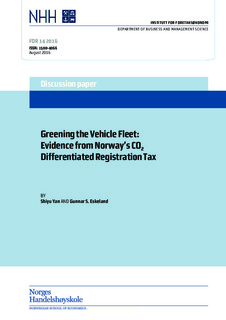Greening the Vehicle Fleet: Evidence from Norway’s CO2 Differentiated Registration Tax
Working paper

Åpne
Permanent lenke
http://hdl.handle.net/11250/2404232Utgivelsesdato
2016-08-31Metadata
Vis full innførselSamlinger
- Discussion papers (FOR) [566]
Sammendrag
Fiscal policies are used to improve vehicle fuel efficiency and reduce CO2 emissions in the transport sector. Years of forceful reform in Norway may be seen as informative. From 2007, Norway has linked its new vehicle registration tax to CO2 intensities, later adapting it into a feebate form. We exploit a detailed dataset of new vehicle registrations, using fixed effects and instrumental variables in our econometric analysis. We find that the CO2 differentiated registration tax contributes significantly to shifting purchases towards low-emitting cars. A 1000NOK tax increase (about 120USD) is associated with a reduction of 1.13% - 1.58% in vehicle registrations, and the responsiveness in car choice to fuel costs is of the same magnitude. The estimated effect of the tax explains the majority (79%) of the reduction in average CO2 intensity in the new car fleet 2006 through 2011. A point estimate of the elasticity of the CO2 intensity with respect to the CO2 price is minus 0.06, whereas the elasticity with respect to (resulting) car prices is about minus 0.5. An intuitive model with ‘all’ car types losing demand to low-emitting types applies fairly well: low-emitting segments gain in share and do not get CO2 leaner, while high-emitting segments lose in share and become CO2 leaner. Moves between nine segments and within those segments are equally important.